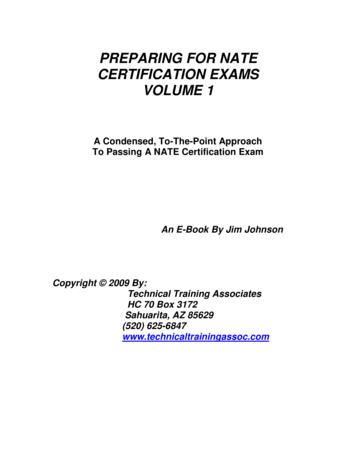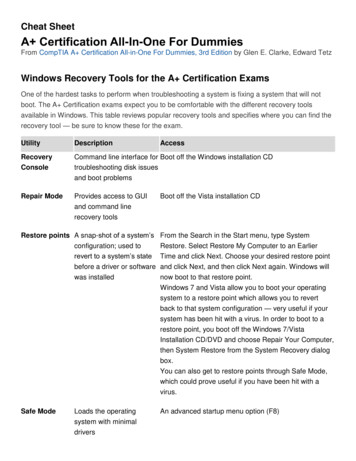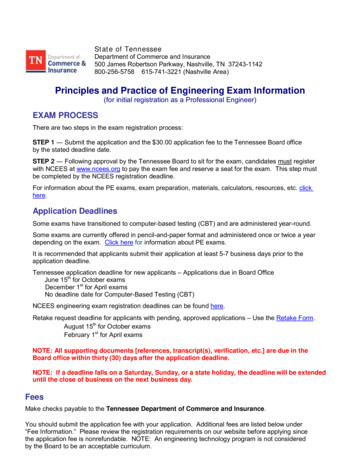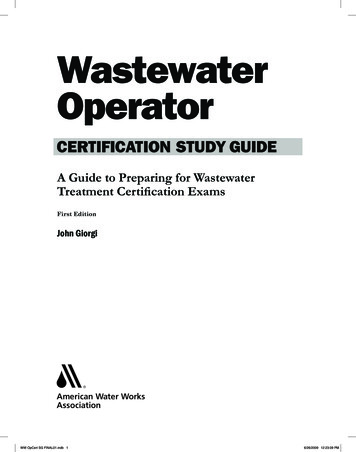
Transcription
PREPARING FOR NATECERTIFICATION EXAMSVOLUME 1A Condensed, To-The-Point ApproachTo Passing A NATE Certification ExamAn E-Book By Jim JohnsonCopyright 2009 By:Technical Training AssociatesHC 70 Box 3172Sahuarita, AZ 85629(520) 625-6847www.technicaltrainingassoc.com
2PREPARING FOR NATE CERTIFICATION EXAMSAn E-Book By Jim JohnsonA Condensed, To-The-Point Approach To Passing A NATE Certification ExamCopyright 2009 Technical Training AssociatesHC 70 Box 3172Sahuarita, AZ 85629(520) m.netAll hard copy and digital copyrights reserved. Distribution of copies to the publicfor sale, or digital copying of any and all information contained herein isprohibited.
3PREPARING FOR NATE CERTIFICATION EXAMSAn E-Book By Jim JohnsonA Condensed, To-The-Point Approach To Passing A NATE Certification ExamFORWARDMYTHS, MISPERCEPTIONS AND REALITIES ABOUT CERTIFICATIONIt‘s been many years ago, but I‘ll never forget it. A service industry wastrying to get a technician certification program up and running. In the midst of allthe brough-ha-ha about it, the association that had developed the certificationtesting program made wonderful predictions of the tremendous success of theirinitiative. I, on the other hand (though I‘m usually optimistic about things), hadpredicted that the program would fail miserably. I was right. The association thatspent a huge amount of money, and invested a great deal of time and otherresources in the development of the exams, wound up selling the program for 1to a trade association in the same industry who thought they might make a go ofit. They didn‘t. The program died, and never came back to life.Why was I so sure that it wouldn‘t work? Actually, there were two keycomponents to my reasoning. First and foremost, the only thing they had to offerwere the exams themselves, (no recommended study materials or opportunity forpreparation) and they expected technicians to show up with bells on to takethem. They announced the date that they were going to launch the program, andlater said that they had a large number of technicians who had committed to takethe exams. When I heard the numbers they were bandying about, I said somethings that most people didn‘t like to hear that on that particular day that theexams were scheduled, although many people had committed to taking them,there would be more sick kids, broken-down vehicles, dying grandmothers, etc.than you could shake a stick at on that particular day and that‘s exactly whathappened.The bottom line was that the technicians, who were supposed to take theexams, were, like many people who work in the service and repair of equipment,good at what they did, and knowing what to do. What they didn‘t have was aconfidence that they knew why something should be done, or the fundamentaltheories of electricity, refrigeration, and mechanical concepts that applied to theirwork. Of course, they didn‘t want to be portrayed as somebody who didn‘t knowwhat they were doing because they failed a written exam, so, in large numbers,they didn‘t show up, even though they promised the would.The second component to my reasoning is best explained by relating aconversation I had with a group of about 50 technicians (I was facilitating atraining session at a national convention) in the midst of this certification initiative,and I asked them a question: ―When are you going to get certified?‖Their answer was simple: ―When customers start to ask for it.‖
4After getting that answer, I went directly to the trade association presidentand asked him when they were going to let the public know that they should beasking about a technician‘s certifications before agreeing to book a service call.His response was, ‖When we have a large enough group of technicians who arecertified.‖Hmmm .ever heard of the term ―Catch-22‖? It‘s a term that has beenused in the Air Force to describe the situation in which a pilot needs to bepsychologically stable in order to be allowed to fly, but, the general opinion is thatpeople have to be a little nuts to want to fly certain missions in the first place, sothey can‘t let him fly because he‘s not nuts or, maybe not nuts enough orsomething like that. At any rate, the trade association was waiting until they hadenough certified technicians before launching an advertising campaign toeducate consumers about the benefits of having a certified technician do theirrepair work, and the people who were supposed to make up the group ofavailable certified technicians were waiting until the consumers (who had no cluethat they were supposed to ask) asked about technician certification. Like I said,Catch-22.The bottom line with NATE certification is that neither of the two issuesthat caused the collapse of that technician certification initiative applies to itscertification program. There are many opportunities (this e-book is one of them)for technicians to prepare for taking the certification exam, and NATE does offerthe consumer the opportunity (via advertising and a Web site) to becomeeducated on technician certification and the fact that they should be asking for it.So, no, NATE isn‘t going to die. It will continue to grow. Consumers will be moreaware about asking about it. Manufacturers will require dealers to have a givennumber of NATE certified technicians on board in order to sell and install theirequipment, and NATE certification will become an issue relative to state licensingof contractors. That‘s the reality of NATE certification.On to some myths and misperceptions on the subject of certification .If you were to ask anyone from the general public what they think whenthey see that a technician is certified, or that a business employs certifiedtechnicians, you would, with continued probing for information, likely hear fromthem that they believe some sort of government agency regulates thecertification process of said technicians. And, of course, they would be wrongabout 90% of the time. Sure, there are some specialty technician certificationsthat are overseen by some sort of ―Big Brother‖ agency, be it a federal, state,county or city government, but they are not in the majority. For the most part(NATE included) the government doesn‘t get involved in the requirements setdown for certification testing. It‘s left up to the industry (who better would knowwhat the professionals working in a particular industry should know in order to becertified?) to determine what competencies must be demonstrated in order to beawarded certification.Here‘s one example .AWS, the American Welding Society, has beencertifying welders for decades. If you‘re a welder and you want to get a job doing
5pipe, structural, or any other type of welding, when you apply for the job there isalways one question asked .‖Do you have your AWS cert?‖And there never has been so much as one bureaucrat involved in settingthe standards for welder certification. AWS was born when a small group ofprofessionals in the welding industry decided that a certification initiative wasnecessary, and welds are x-rayed to make sure they‘re done properly before awelder can be certified in a given skill.How about this one ? ASE, Automotive Service Excellence. Formerlyknown as NIASE, the National Institute for Automotive Service Excellence, thisorganization certifies technicians in specialty areas such as brakes or alignment,among other disciplines within the automotive service industry. And whichgovernment agency is that oversees the setting of standard for thesecertifications? None. Those ASE-Certified signs you see in independent garagesand car dealers around the United States are the result of an industry, and onlythe industry, creating and implementing its own technician certification program.Again, though, from a consumer perspective, the underlying idea that somebody,somewhere in a conference room or office in Washington D.C. regulates whatgoes on with automotive technicians and their being certified, is likely what youcould easily get people to accept.But there‘s a reality amid the consumer‘s misperceptions about the term―Certified‖. It gives them a feeling of confidence. That‘s why some HVACR andmajor appliance service contractors have ―Certified Technicians‖ painted on theside of their service vans even if it only means that the technicians who serviceequipment are EPA certified in refrigerant handling procedures. And, c‘mon,anybody who works in the refrigeration industry knows that anybody who wantsto study for a while about rules and regulations relative to Section 608 of theClean Air Act, recall some specific dates when certain laws when into effect, and,OK, be able to answer a few questions about the fundamentals of a refrigerationsystem, can pass an EPA certification exam segment, by answering more than17 out of 25 multiple-choice questions correctly. But that doesn‘t change the factthat it makes consumers feel better about buying service from a company thatlists their technicians as certified. They still do.Beyond that perceived reality, though is another more ―realistic‖ reality.NATE certification is a process that enhances a technician‘s confidence andcompetence. The facts cannot be denied. A NATE certified technicianexperiences fewer callbacks. And in the end, that‘s a win/win/win/win .a win forthe consumers because they get quality work, a win for the HVACR sales andservice organization because their expenses go down, a win for the technicianbecause when expenses go down that means there are more resources that canbe channeled into a technician‘s earnings, and win for the HVACR industrybecause as the standards are raised, the industry itself has more credibility,which will attract the much-needed new blood that will allow it to grow andprosper.and that‘s exactly what I want this book to help you do as you preparefor your NATE certification exams.
6PART ONEWHAT TECHNICIANS NEED TO KNOW ABOUT NATEHVACR technical professionals please be advised: NATE is it. What do Imean by that? Well, it‘s pretty simple. Any industry goes through changes astime goes on, and one of the changes that the HVAC/R industry has gonethrough in the last decade relates to technician certification.Other than the required EPA Refrigerant Handling Certification requirements,HVAC/R technician certification via a testing process has, historically, beensomewhat limited. Since NATE (North American Technician Excellence) wasincorporated in 1997 as a nonprofit testing and certification organization ―for thepurpose of recognizing and promoting technician excellence in the installationand service of heating and cooling equipment‖ though, the momentum of theprogram has been steady.And now, as I said, NATE is it. It‘s time for every HVAC/R technician,service manager, contractor and educator to recognize that fact, and considertechnician certification as the norm rather than the exception. For my part in thiseffort, I‘ll be presenting a series of articles that will assist technicians in achievingtheir goal of certification. Some of what you read in this e-book will be simple,straightforward information on how the testing process works and what it will takefor technicians to successfully achieve their goals relative to certification, andsome of it will appear to be quite opinionated—because it will be an opinion—mine, that is.A Bit of History On HVAC/R Technician CertificationWhen looking back on the history of HVAC/R technician certification, onehas to consider RSES (Refrigeration Service Engineers Society). Theirorganization, made up of members who are first and foremost technicalprofessionals (sure, a member might also be a business owner, but membershipin RSES is based on being a technician first) in refrigeration, air conditioning andheating, has offered a certification process for many years.Members have had the option to choose to achieve what is known as CM(Certified Member) status by successfully passing a test. At another level is adifferent test involving the CMS (Certified Member Specialist) status. The testingprocess has always been tough, as anything worthwhile is, and often, eventechnicians with a history of experience in HVAC/R, didn‘t pass the first timearound. But, those who persevered, more often than not, did pass with a secondeffort, and were awarded a CM or CMS member status. The certification processhas always been on a voluntary basis, as it still is (to a certain degree—I‘llelaborate on that shortly) today in the HVAC/R industry.If you‘re a technician working in HVAC/R and you‘re not a member orRSES, you should be. The investment of one hundred-bucks or so a year is asmall one to consider in the scope a technical professional‘s career, and whatyou gain from being a member, attending monthly chapter meetings and
7participating in the education provided there (not just from the people who arescheduled to do the presentations, but from the others who attend) isimmeasurable.RSES and CARSES also regularly sponsor technician education seminarsand workshops, and being a member allows you to attend at a lower fee thannonmembers. (CARSES, by the way, as I‘ve been told, stands for CaliforniaArizona Refrigeration Service Engineers Society even though the regionalorganization also includes Nevada and Hawaii. If I haven‘t got that quite right,somebody please get in touch with me and we‘ll set the record straight.)What‘s that you say? You‘re a technician who believes that if you‘re goingto be a member of RSES, your employer should pay for your dues for you? Well,everybody is entitled to an opinion, but that‘s not mine.If an employer chooses not to assist in underwriting a technician‘s professionaldevelopment by either covering or splitting the expense of individual membershipdues to an organization that will assist you in reaching career goals, then suck itup, pay your dues, join, and claim it as a deduction on your income taxes. Butjoin. RSES, with their history of providing education for HVACR technicians canassist you in a variety of ways in achieving NATE certification.Of course, NATE certification is voluntary, as most technician certificationin the HVAC/R industry has always been. But that may be changing for sometechnicians. Some manufacturers (and I wholeheartedly agree with them) arerequiring contractors to have a given number of NATE certified technicians onboard in order to sell their equipment. And some states are considering a NATErequirement for those who want to get a contractor‘s license.Bravo on both counts as far as I‘m concerned. The facts about NATEcertification are measurable and undeniable. NATE certified technicians makefewer mistakes relative to the installation, diagnosis and troubleshooting ofHVAC/R equipment. And that is a win-win-win.First, it‘s a win for technicians because they become more confident andcompetent in their craft. Second, it‘s a win for HVAC/R customers—the bottomline in any business—because they get better quality service. And, third, it‘s awin for the HVAC/R industry. Raising the standards of the industry enhances ourimage in both the eyes of our customers and the young men and women whomay consider HVAC/R as a career.A Few Words on NATE CriticismsAt the risk of sounding like some Old Duck who longs for ―the good olddays‖ (really, I‘m not), I want to make a point about technician certificationprogram criticisms by discussing one of the first EPA certification testingsessions that took place in San Francisco in the early ‘90s.When I attended that session and tested along with a couple hundred othertechnicians, I heard a lot of criticisms about the whole idea of EPA RefrigerantHandling Certification, that it was nothing but a farce, a way to wring money outof HVAC/R technicians. And, it‘s likely that you can still find people today whoexpress that opinion.
8Believe me, I‘ve heard it all, from ―there‘s not really a hole in the ozone‖ to―the space program dumps more chlorine on one launch that a thousandtechnicians do in a lifetime‖ to ―volcanoes are responsible‖ to ―rain washes thechlorine out of the atmosphere,‖ etc., and we finally made a rule during thetraining sessions we presented and the testing sessions we proctored: everybodywas entitled to their opinion, whatever it was, but when it came to answering thequestions and earning the certification, the EPA was right.To put it simply: all right all ready, nothing‘s perfect. So, now that we‘veestablished that, let‘s move on.There have been some criticisms in the past (and likely will still be some foreverno matter what changes are made) about NATE test questions that are notrelative to the real ―nuts and bolts‖ of HVAC/R equipment servicing, and serve toprove nothing about a technician‘s real competency. Well, that may be true to acertain degree, but it‘s certainly not true of every question, or even the majority ofquestions on the various exams.So, all right all ready, do you want to be right, or do you want to be happy?Consider this scenario: you‘re crossing the street and you‘re doing everythingright. You wait for the walk sign, you look both ways, you stay in the crosswalkand you have plenty of time to get to the other side of the street, so you‘re totallyright. Then, a speeding car shows up out of nowhere and mows you down. Youcould, as you‘re lying there and taking your last breath, point a finger at the driverof that car and you‘d be right about the fact that he was totally in the wrong andyou were totally in the right. But you‘d still be dead.So, do you want to be right, or do you want to be happy?A NATE test packet always contains an evaluation that allows techniciansto provide an opinion on the test itself, and make comments and offersuggestions for improvement. It‘s through the process that some changes havebeen accomplished, and any future changes that are necessary will be made.Other criticisms that you may have heard about the NATE exam process is thatthe fees should be lower, and that the certification should not need to berenewed. Neither of these issues should even be raised. If you think the NATEtesting fees are excessive, look into what other professionals pay for certificationin their area of expertise. And on the issue of renewing the certification,c‘mon our industry, like any other industry that relies on technology, is everchanging. So recertification in an updated environment makes perfect sense.The NATE StructureFirst, you need to decide is what category of technician you are. The twotypes of certification are Installation Technician and Service Technician. Here‘sNATE‘s description of what an installation technician does:―Primarily prepares the installation site (including removal of the existingHVAC/R equipment), fabricates connections, and assembles systems asspecified in the installation instructions. The technician must be able to properlypower up and set control positions to cycle equipment through primary heating,
9cooling, and blower operation under on-site or off-site supervision of a service orsenior technician. The installation technician takes specialized readings such astemperatures, refrigerant circuit pressure, and basic VOM electrical readings,with both operating and non-operating equipment, as may be required by others.‖And the NATE service technician responsibilities include the following:―This technician must be able to accomplish the same tasks as aninstallation technician, as well as to independently power up and adjust controlsettings to cycle equipment through all designed-for sequences. A servicetechnician must be able to acquire, evaluate, and interpret such readings as maybe necessary to determine the adequacy and acceptability of system operation tomeet specifications. This technician must be able to perform sufficient fielddiagnostic procedures as necessary to determine causes of inadequateperformance and identify corrective actions as needed.‖Under the NATE certification system, a service technician is considered tooften possess the same knowledge as an installation technician. This being thecase, a technician who certifies under the Service category can order and payseparately for a wallet card and certificate for the Installation category when theyaccomplish the Specialty exams.Before a technician is eligible to take a specialty exam, they mustaccomplish a core exam that covers safety, customer service, principles of heattransfer and total comfort, and fundamentals of electricity. The core examconsists of 50 multiple-choice questions.In the specialties area, each exam consists of 100 multiple-choice questions, arefocused on the following:Air ConditioningAir DistributionGas HeatingHeat PumpsOil HeatingIn the case of both the core exam and the specialty exams, a technicianmust achieve a score of 70 or better to earn certification. A technician whoaccomplishes the heat pump certification exam is automatically certified in the airconditioning category. NATE‘s approach to the structure of the exams is that theyare designed to measure what 80 percent of technicians have an 80 percentprobability of needing to know to do their job correctly.And that‘s our introduction to the NATE certification process, along with some ofmy opinions about it. Your opinions on NATE, and any information aboutexperiences that you‘ve had if you have participated in the certification process,are welcomed. In the next segment in this series, we‘ll take a closer look at theconcepts a technician needs to understand relative to the core exam. For moreinformation on NATE, visit www.natex.org.
10PART TWOCORE EXAMSWhen a technician is pursuing NATE certification, the first step is to accomplish acore exam. Core exams in either the area of service or installation evaluate atechnicians understanding of the fundamental concepts applied to HVAC/Requipment servicing (relative to refrigeration and electricity), as well as safetyissues, an understanding of tools, and soft skills. All of which makes sense. Afterall, how can a technician perform effectively relative to comfort cooling, forexample, without a firm understanding of the fundamentals of temperature andhumidity measurement, how a refrigeration system works in conjunction with anairflow system, and how the basic sciences apply to the proper operation of asystem? It‘s the same as building a house. Without the proper foundation, youwon‘t have much of a building. And so it goes with demonstrating proficiency inheat pumps, gas heat equipment or airflow systems. (For a listing of the specificNATE categories of certification, see Part One)Without the proper foundation of understanding, you can‘t be as effectiveas possible when troubleshooting and servicing comfort cooling, heating, orrefrigeration systems. Some of the stuff a technician needs to know about coresubjects is very straightforward, such as terms we should be familiar with whenworking in the HVAC/R industry. For example:Sensible Heat: Heat that can be measured and felt.Dry Bulb Thermometer: A temperature-measuring device used to measuresensible heat.Latent Heat: Often referred to as ―hidden heat‖, it cannot be felt or measured,occurring during a phase change of a solid to a liquid, liquid to a vapor, or viceversa.BTU: British Thermal Unit, the amount of heat it takes to raise the temperature ofone pound of water one degree Fahrenheit.Hmmm seems pretty straightforward, doesn‘t it? While the average person onthe street would probably give you a puzzled look if you asked them to explainany of these simple terms, 99.9 percent of HVAC/R technicians would likely beable to recite the formal definitions we‘ve listed here, as well as provide anexplanation as to how they fit into the concept of heat transfer. And, beyond that―foundation‖ stuff, there‘s the issue of actually paying the rent with that basicunderstanding.What do I mean by ―paying the rent‖? Well (get ready, here comes anopinionated point-of-view), what I mean by that is that it‘s nice to know stuff, but itisn‘t worth much if you can‘t find a way to pay the rent with it: put it into practicalapplications and accomplish some goal. In this case, the goal and the practicalapplication are to be able to answer a test question relative to these fundamentalterms. And I mean answer it. Not just by memorizing some information, thenregurgitating at the appropriate time to choose A, B, C or D, but being able to
11understand the concept so you can figure out what the correct answer would beto any question relative to that concept. For example, take a look at the drawingin 2-1.Figure 2-1First, note our thermometer illustrations that represent temperature. Thereare two showing 32-degrees and one showing zero. Note also that we‘re usingtwo of the specific terms we mentioned above, sensible and latent heat. We‘vealso added the idea of change of state to make out point. And, it‘s clear that ourdiscussion on this concept is going to apply to the idea of removing heat from agiven quantity of water and causing it to change in state from water to ice.Beginning at the left of our illustration, you could assign any temperature youwish, and you could also use any given quantity of water you want. For the sakeof discussion, let‘s say that we‘ll be using one pound of water at 70-degrees F.With that understood (and recalling the definition of the term BTU) we coulddetermine exactly how much heat would need to be removed in order to chill thewater from 70 down to 32.So, if our question was:In the accompanying illustration, how many BTU‘s of heat would be removedfrom one pound of water being chilled from 70-degrees F, down to 32-degreesF?A. 40B. 32C. 38D. 70What was your choice? How did you arrive at your answer?If you chose ―C‖ you were correct. And, if you arrived at that answer by recallingthat the definition of the BTU is ―the amount of heat it takes to raise the
12temperature of one pound of water one degree Fahrenheit‖, then applied thatinformation to the concept of removing heat rather than adding, and then didsome simple math—the difference between 70 and 32 is 38—then you answeredthe question by understanding a concept and being able to apply your ability toreason.And what if you understood the concepts we‘ve been discussing, and yourquestion (refer to Figure 2-2) was:Figure 2-2The type of heat that must be added or removed to cause a change in thephysical state of a substance is:A. Specific HeatB. SuperheatC. Latent HeatD. Sensible HeatWhich answer would you choose? It‘s ―C‖ again, because the conceptwe‘ve illustrated clearly shows that the change in the physical state of asubstance (when water is in the process of becoming ice in this case), the type ofheat being removed is latent heat. When you‘re at the ―beginning‖ of 32, yoursubstance is a liquid. During 32, your substance changes in state from a liquid toa solid and you now have ice, once you reach the ―end‖ of 32. Hence thedefinition of latent heat is ―heat that brings about a change in state, but not achange in temperature‖.Now, referring again to Figure 2-2, on to your third question:When one pound of ice is chilled down from 32 to zero degrees F, what type ofheat is being removed?A. Sensible HeatB. Latent HeatC. SuperheatD. Specific Heat
13What did you choose this time? If you picked ―A,‖ you were correct.Clearly, the latent heat process has been accomplished, and the numbers in ourquestion illustrated a measurable drop in temperature, which means sensibleheat—heat that can be measured—is the correct answer.By the way, did you notice that in this question, there was some information thatdidn‘t really need to be there? The ―one pound of ice‖ reference could be deletedfrom the question and it wouldn‘t affect the answer. The concept that needed tobe understood didn‘t concern the amount of heat being removed, only the type ifheat. Now, if the question read How many BTU‘s of heat are removed when one pound of ice is chilled downfrom 32 to zero-degrees F?A. 32B. 16C. 64D. 48 there‘s another concept that needs to be understood, which is referred to asthe specific heat capacity of a substance. In the case of water in the first questionwe presented the answer was straightforward because the specific heat capacityof water is 1. However, to get the answer correct about ice, you would have tounderstand the concept of the specific heat capacity of a substance changing inthe event of a change in state. The specific heat capacity of ice is .5, whichmeans that the correct answer to our question would be ―B‖, which we wouldarrive at by again doing simple math as we did in the first question.
14PART THREEMORE ON CORE EXAMSIn Part Two, we presented some very fundamental information on theconcepts of heat transfer (thermodynamics, if you prefer). And we accomplishedthat by discussing first, some basic terms an HVAC/R technician needs tounderstand, then relating that information to concepts that need to beunderstood, not just from an academic perspective, but from a practical approachto understanding refrigeration systems so as to be able to evaluate a system,determine whether or not it‘s operating properly, and then accomplish a repair if itisn‘t. That, in my opinion, is the underpinning of the NATE philosophy. Thedesign and approach of an exam should allow a technician to demonstrate theirunderstanding (and competency) relative to their craft—not just by rememberingformal definitions through a rote process, by being able to apply the knowledge ofthose definitions and the concepts they represent to a given situation, thenanswer the question correctly. As an example of this process, consider thesimplified drawing of a refrigeration system in Figure 3-1.Figure 3-1
15At this point, we don‘t know the exact application of this refrigerationsystem—whether it‘s comfort cooling, a walk-in cooler, a heat pump, or even anautomobile air conditioner or a household refrigerator/freezer. And, at this point,we don‘t care.The idea we want to get across here is t
PREPARING FOR NATE CERTIFICATION EXAMS An E-Book By Jim Johnson A Condensed, To-The-Point Approach To Passing A NATE Certification Exam FORWARD MYTHS, MISPERCEPTIONS AND REALITIES ABOUT CERTIFICATION It's been many years ago, but I'll never forget it. A service industry was trying to get a technician certification program up and running.










